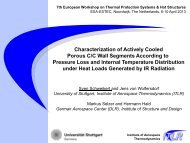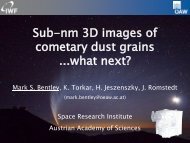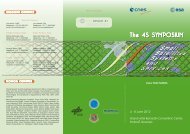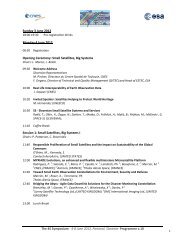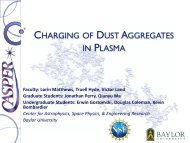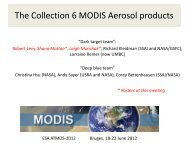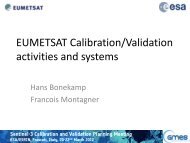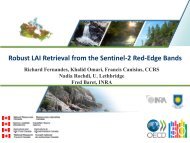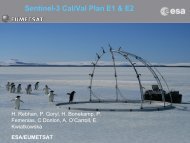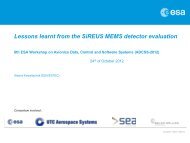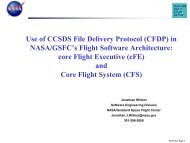Sea Ice Remote Sensing – From Global to Local View Wolfgang
Sea Ice Remote Sensing – From Global to Local View Wolfgang
Sea Ice Remote Sensing – From Global to Local View Wolfgang
Create successful ePaper yourself
Turn your PDF publications into a flip-book with our unique Google optimized e-Paper software.
<strong>Sea</strong> <strong>Ice</strong> <strong>Remote</strong> <strong>Sensing</strong> <strong>–</strong><br />
<strong>Wolfgang</strong> Dierking<br />
Alfred Wegener Institute<br />
for Polar- and Marine Research<br />
Bremerhaven, Germany<br />
PALSAR 21031139, WB1-HH<br />
<strong>From</strong> <strong>Global</strong> <strong>to</strong> <strong>Local</strong> <strong>View</strong><br />
<strong>Sea</strong> ice concentration Sep. 2007<br />
June 2012<br />
Markku Similä and Marko Mäkynen<br />
Finnish Meteorological Institute<br />
Helsinki, Finland<br />
DLR-ESAR<br />
L-Band<br />
Quad-pol<br />
200307
European partners: from Finland and Germany
<strong>Sea</strong> <strong>Ice</strong>: Field Observations<br />
Altitude 30 m<br />
Altitude 900 m
<strong>Sea</strong> <strong>Ice</strong>: Deformation
<strong>Global</strong> <strong>View</strong>:<br />
Satellite observations of the entire Arctic/Antarctic<br />
Among the „hot <strong>to</strong>pics“ of recent polar research: the decreasing<br />
sea ice extent in the Arctic, here observed from space<br />
Sep. 2005 Sep. 2006 Sep. 2007<br />
sea ice<br />
concentration<br />
Sep. 2008 Sep. 2009 Sep. 2010 www.seaice.dk
Some details about Arctic sea ice decline:<br />
<strong>Global</strong> climate change<br />
affects Polar Regions<br />
Changes in the Polar<br />
Regions affect global<br />
climate<br />
Source:NSIDC<br />
Decline 12.0% per decade<br />
decadal trend:<br />
particular month<br />
seasonal<br />
variation<br />
for each<br />
year
<strong>Global</strong> <strong>View</strong>:<br />
Satellite observations of the entire Arctic/Antarctic<br />
Example: sea ice drift<br />
• Transport of mass, heat and salinity<br />
• Drift results from atmosphere- sea ice <strong>–</strong> ocean interactions
<strong>Global</strong> <strong>View</strong>:<br />
Satellite observations of the entire Arctic/Antarctic<br />
Averages between 1979<br />
and 2007:<br />
Melt season starts earlier<br />
by 2.8 d /10 yr<br />
Refreezing starts later<br />
by 3.7 d /10 yr<br />
Length of melt season<br />
inreased by 20 d / 30 yr<br />
Example: melt season observations<br />
using passive microwave radiometers<br />
http://www.nasa.gov/<strong>to</strong>pics/earth/features/longer-melt-season.html
<strong>From</strong> <strong>Global</strong> <strong>to</strong> <strong>Local</strong> <strong>View</strong>:<br />
• <strong>Global</strong>:<br />
Satellite observations (ice concentration, extent, motion etc)<br />
are used for moni<strong>to</strong>ring „large-scale“ processes (≈1000 km)<br />
and as validation data for global coupled (atmosphere)- sea<br />
ice <strong>–</strong> ocean models<br />
Instruments: passive microwave radiometers + scatterometers<br />
with high temporal coverage, wide swath (>500-1000 km)<br />
but coarse (10-50km) spatial resolution<br />
Optical instruments: limited use (cloud coverage, polar night)
Regional <strong>View</strong>:<br />
Satellite observations of key regions<br />
Baltic <strong>Sea</strong><br />
C-Band (Envisat ASAR WSM)<br />
13. März 2007<br />
(swath 400 km, res. 150 m, 11 looks)<br />
L-Band (ALOS PALSAR ScanSAR)<br />
12. März 2007<br />
(swath 150-250 km, res. 100 m, 8 looks)<br />
• Radar: operational sea ice moni<strong>to</strong>ring in support of ship traffic<br />
• Regional forcasting of sea ice conditions using simulation models
Requirements:<br />
• cost-efficient<br />
• safe<br />
Marine traffic in ice-covered waters
Detailed maps of ice conditions<br />
Zoom-In: Bothnian Bay / Baltic <strong>Sea</strong>
Regional <strong>View</strong>:<br />
Satellite observations of key regions<br />
FMI: Kara <strong>Sea</strong> Project<br />
Radarsat-2 Wide Swath Dual-Pol.: HH + HV<br />
Research:<br />
•Improvement of<br />
ice classification<br />
schemes<br />
• Regional process<br />
studies (“a-si-o“<br />
interactions)<br />
• Studies of different<br />
ice regimes
Regional <strong>View</strong>:<br />
Satellite observations of key regions<br />
<strong>Ice</strong> thickness chart, 4 March 2009.<br />
FMI: Kara <strong>Sea</strong> Project<br />
AARI ice chart<br />
Color codes:<br />
green =<br />
thin FYI 30-70 cm,<br />
light blue =<br />
FYI 70-120 cm,<br />
others=<br />
thin ice 0-30 cm.<br />
• Combination of<br />
data from different<br />
satellite sensors<br />
(radar, optical,<br />
passive microwave)<br />
and modelling<br />
for retrieval of<br />
geophysical<br />
parameters:<br />
e. g. ice thickness
Regional <strong>View</strong>:<br />
Satellite observations of key regions<br />
• Polynias as „sea ice fac<strong>to</strong>ries“ and areas of strong regional<br />
and local interactions between atmopshere, ice, and ocean
<strong>From</strong> <strong>Global</strong> <strong>to</strong> <strong>Local</strong> <strong>View</strong>:<br />
• Regional:<br />
Satellite observations for operational sea ice moni<strong>to</strong>ring,<br />
and science studies, often supplemented by aircraft<br />
data acquisitions and regional measurement networks<br />
(meteorological stations, ocean drift buoys etc.) <strong>to</strong><br />
improve sea ice classification and parameter retrieval<br />
Instruments: SAR (wide swath /ScanSAR), optical sensors<br />
(VIS, IR, TIR) with spatial resolutions 100 m <strong>–</strong> 1km, swath<br />
widths 400 <strong>–</strong> 500 km, temporal resolution < 1 day
<strong>Local</strong> <strong>View</strong>:<br />
Satellite observations of small scales<br />
• <strong>Local</strong> processes (paramterizations for sea ice models)<br />
• Example: atmospheric drag coefficient over sea ice
25 km<br />
15 km<br />
<strong>Local</strong> <strong>View</strong>:<br />
Satellite observations of small scales<br />
• Detailed view of ice cover structure (ridges, leads...)<br />
Radarsat-2<br />
Fine Quad-Pol<br />
03-06-2008<br />
HV-HH-VV<br />
TerraSAR-X<br />
StripMap<br />
03-06-2008<br />
VH-VV-VV
<strong>From</strong> <strong>Global</strong> <strong>to</strong> <strong>Local</strong> <strong>View</strong>:<br />
• <strong>Local</strong>:<br />
Satellite observations of ice ridging and pressure zones for<br />
operational sea ice moni<strong>to</strong>ring, sea ice process studies<br />
supported by field measurements (ground-based, airborne)<br />
Detailed comparison between different radar systems<br />
(as preparation for new satellite missions: airborne SAR)<br />
Instruments: SAR (imaging modes), optical sensors<br />
(VIS, IR, TIR) with spatial resolutions 1-30 m , swath<br />
widths ≤ 100 km
41<br />
40<br />
39<br />
38<br />
37<br />
<strong>From</strong> <strong>Global</strong> <strong>to</strong> <strong>Local</strong> <strong>View</strong> <strong>–</strong> Research in the Bohai <strong>Sea</strong><br />
Bohai bay<br />
Liaodong bay<br />
Bohai <strong>Sea</strong><br />
Laizhou bay<br />
118 119 120 121 122<br />
ENVISAT ASAR WSM VV (2011.2.3)<br />
2009-01-14;RS-2 Fine Quad Pol.<br />
(VV, VH, HH)<br />
• Research consists of local and regional studies<br />
• Bohai <strong>Sea</strong> represents an own ice regime<br />
• Complements work of Sino-European team in Arctic/Antarctic, Baltic




